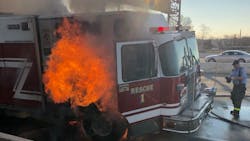Baltimore City FD Faces Questions over Apparatus Fire
The Baltimore City Council plans to summon Fire Department leaders for hearings after an aging firetruck caught fire and amid warnings from the firefighters' union about the agency’s readiness to respond to emergencies.
Councilman Brandon Scott, chairman of the public safety committee, said the first hearing will be one of a series to keep a closer watch on the department.
“It’s a direct response to citizen complaints about the Fire Department and service,” Scott said.
The hearing was scheduled for Tuesday but was canceled because of bad weather. Scott is expected to announce a new date at Monday’s City Council meeting.
Over Christmas, the International Association of Firefighters Local 734, the city firefighters’ union, said two stations were temporarily out of service because they lacked equipment, making the department slower to respond.
RELATED:
- Baltimore City FD 'Well-Equipped' Despite Out-of-Service Units
- Baltimore City Mayor Promises $1.2M Apparatus
- Baltimore City Apparatus Catches Fire
A department spokeswoman said then that its ability to provide emergency services was not affected, but Mayor Catherine Pugh subsequently set into motion plans to buy an extra $1.2 million firetruck.
Then, last month, a firetruck caught fire — and it wasn’t the first time it’s happened in Baltimore. The union said the truck was 17 years old.
IAFF Local 734 President Richard “Dickie” Altieri posted about the incident on his Facebook page, saying the rescue truck was responding to an incident on Interstate 95 when it caught fire. He said it shows that the “dilapidated fleet needs attention sooner than later.”
The “unfortunate and potentially fatal incident reminds us that this situation is far from resolved and remains the most critical issue our city faces,” he wrote in a statement. “The safety of our community … as well as our firefighters … depends on it.”
Alteiri did not respond to requests for comment, but Rick Hoffman, a retired firefighter and Altieri’s predecessor at the union, said increased city oversight is “probably overdue” for the department.
“I’d love to see someone come in and look at how upper management is doing things,” he said. “Anytime you can try to improve something, why not go for it? There’s a lot of waste in the Fire Department, in the Police Department, a lot of waste everywhere.”
Scott said he hopes the hearings will be similar to those the council recently started holding with officials from the Police Department, delving into performance issues and highlighting problems. He said the agenda for the first meeting is “literally every single thing about the Fire Department.”
Fire Department spokeswoman Blair Skinner said the department doesn’t know of any particular questions that will be asked.
“We will attend and respond accordingly to address any issues or concerns as it relates to the Fire Department,” Skinner said.
The city’s lawyers declined previously to release data on Fire Department response times, saying in response to a Public Information Act request that it didn’t have any records to share. But some figures are reported as part of the annual budget process.
In 2017, the latest year for which statistics are available, the Fire Department had an engine respond to a fire within 5 minutes 95 percent of the time, beating a 90 percent goal.
But it missed a target of having emergency medical crews respond within 8 minutes 90 percent of the time; instead it did so 45 percent of the time. Dispatchers narrowly fell short of goals for how quickly they should answer and handle calls.
In 2017, Baltimore had 20 fatal fires — almost double the department’s goal.
Stephen Holloway lives in Baltimore’s Dorchester neighborhood with his wife and parents — just a few blocks from the Liberty Heights Avenue fire company, which has been out of service since Dec. 24.
Holloway had not heard of the Fire Department’s problems but said it was “disheartening” to learn the City Council felt the need to hold hearings to review the agency’s functionality.
“In the grand scheme, we need someone to be here quickly,” Holloway said.
A number of houses in the neighborhood are vacant or being renovated and flipped for profit, including the one next door to Holloway’s family home, he said.
Over the years, city and fire officials have pointed to Baltimore’s surplus of vacant structures as a potential source of serious fire and safety problems.
In the event of an emergency, Holloway said, every second would count.
“If first responders are miles away, it can be a matter of life and death,” he said.
Still, other neighborhood residents such as John Legge said they have not noticed any problems with response times from fire officials. Legge lives a few houses down from the Liberty Heights Avenue station.
Last week, a leak in Legge’s roof caused one of his smoke detectors to get wet and triggered the alarm. Fire officials were there almost immediately, Legge said.
The call for a City Council hearing comes during a particularly dangerous time of year for firefighters. The winter months are typically the busiest for fire departments, and they also can be the most treacherous for those battling blazes.
Baltimore Sun reporter Talia Richman contributed to this article.
———
©2019 The Baltimore Sun
Visit The Baltimore Sun at www.baltimoresun.com
Distributed by Tribune Content Agency, LLC.
